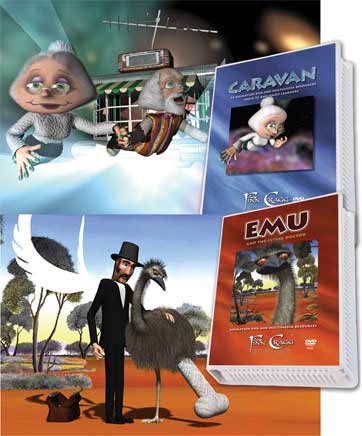ANALYSING CARAVAN – USING THE FOUR RESOURCES APPROACH
These ideas are from Finn Cragg’s teacher workshop “e-Merging Storytellers” at National ATOM Conference 2006, facilitated by Lyn Hawkins, Finn Cragg
lyn@finncragg.com based on Freebody, P., & Luke, A. (1990). Literacies programs: Debates and demands in cultural context. Prospect: Australian Journal of TESOL, 5(7), 7-16 and structured in line with the Learning, Teaching and Assessment Guide
www.ltag.education.tas.gov.au).
Text Participating Questions:
· Prior to watching, predict what you think this animation might be about by looking at the packaging or opening screen and title, or the image from the opening scene?
· Does this animation remind you of something that has happened to you?
· What did you feel as you watched the animation?
· What would you do in this situation?
· How do you feel about the story?
· What extra or new information does the animation give you?
· Are the characters like anyone you know?
· What are the characters thinking or feeling? How do you know that?
· What might have happened to these characters before this? Develop a prequel, storyboard the scenes. Create it.
· What might happen next? What gives you this idea?
· What do you think the next scene will look like? Create it.
· If you could ask the old lady in the animation a question, what would it be?
· If you could ask the old man in the animation a question, what would it be?
Code Breaking Questions:
· How did you work out what the story was about?
· Which aspects of Caravan are symbolic and in what way?
· What is the role of sound in the animation?
· Which other symbols and codes could be used in a story like this?
· Are there any patterns you can identify in Caravan?
· How is the lighting used differently throughout the story?
· What can you tell about the characters even though they don’t speak - how?
· Which scenes have the greatest impact and why?
· Is there an image in the story that is a close up, medium shot or long shot that creates special meaning in the story?
· In what way has colour and texture been used in this animation?
· How has design help create the story e.g. the interior of the Caravan or the caravan itself?
· Choose a scene that appeals to you and explain what is happening in this image and why you like it?
· What do you notice about the body language, facial expressions, clothing and behaviour of the characters?
· What is the meaning of a Caravan journey in the Australian culture?
Text Using Questions:
· What do you notice about the way this animation looks and sounds?
· How is this animation created?
· Which special features does this animation have?
· What is the purpose of this animation?
· In what ways is this animation like others you have seen?
· In what ways is this animated story different from a written story, a comic and/or a movie?
· Does this animation inform you? How?
· What words would you use in this animation? Develop the storyboard interpretations and create dialogue and narrative thinking about intended audience, message and meaning.
· What title would you give it?
· Create a web page, printed advertisement, brochure, poster, media release or commercial for the animation.
· How would the text be different if you were to create a poem or short story inspired by the images? Create one.
· What title would you give this?
· Choose your favourite image or scene and justify why this is your favourite.
Text Analysing Questions
· What do you notice about the way this animation looks?
· What genre would you describe Caravan to be?
· What opinions has the digital author/animator expressed? Why do you think that?
· What is fact and what is opinion in this text?
· What would the story be like if the main characters were young and not old? (or of a different culture?)
· Whose story is or is not being told in the text? Why?
· Is the composer of this text being fair? Explain.
· In whose interest is this text?
· How is the animator trying to make you feel? Why?
· How would this text be different if told in another place or time?
· Who does this text reject, silence or marginalise?
· Focus on the image of the old lady sitting on the thruster, reflecting (or another interesting image). Why do you think the animator created this image? What does it say to you?
· What view of the world and values does the animator assume that the reader or viewer holds? How do you know?
· How does the animation construct a version of reality?
· How does the animation use intertextuality to create its meaning? Give examples.
· Have you changed your opinion about specific people or events after watching Caravan?
· Having critically examined this text, are there any actions you’re going to take or things you would like to do?
NOTES ABOUT CARAVAN:
The five minute animated story is about an elderly couple venturing beyond the confines of their caravan, facing their fears and fragility by reveling in the freedom of space. The animation is accompanied by storyboards, soundtrack, still and animated clips that can be imported in editing programmes, along with original artwork. It is written and created by digital author Martin Davidson and published by Finn Cragg. For more details and a preview see
www.finncragg.com or email
service@finncragg.com.




